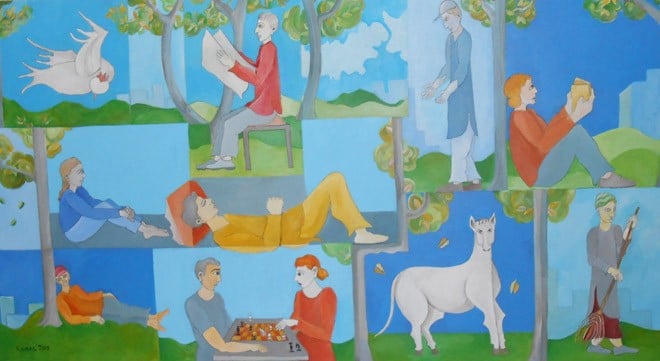

Doubles, however, come cheap these days. Although I am not a well-known writer, I too have one, who performs an increasingly alarming number of public functions…… The other day he was apparently at a bookshop, meeting people, being photographed and parrying questions; while I was at home, in a gloomy corner, trying to write… -- Amit Chaudhury
It is as ridiculous to describe someone as the greatest creative genius as it is to reduce a creative personality to one discipline or to one regional or national identity. In the world of art and literature, there are no means to measure who is the greatest except in a very subjective way. Many big names in poetry and art from our recent past have become obsolete with the passage of time.
Likewise, it is useless to restrict a creative person within one discipline, field or role. Artists shift between teaching art to writing on art to practicing art. Nowhere in the world does one look at the mutilple roles -- artist and art historian, artist and art critic, artist and art teacher as well as artist and art curator -- as an example of conflict of interest. The most relevant name in this regard is of Barnett Newman, the Abstract Expressionist painter, who published several critical essays on art and artists of his age for different magazines and newspapers.
In the realm of literature, too, authors of fiction and poetry have been critics and teachers as well. John Updike, Gore Vidal, Martin Amis, Peter Ackroyd and J. M. Coetzee are a few names who wrote critical essays on their contemporary writers. It would be a shame to think of T.S. Eliot’s poetry and criticism in terms of conflict of interest.
The clarity of Eliot’s thought and quality of his expression make his prose a text that invites you to read, enjoy and understand the nuances of language and crispness of ideas. Not only Eliot or Borges, but every writer in a way is critiquing and commenting on fellow authors, declaring his/her position on the preference, standard and function of art and literature. In that respect, they all act like a critic. The visual artists, too, through their own works show their choices and dislikes and their views on the quality of art.
Just as the distinction between a critic and poet or fiction writer is arbitrary, the division between a trained artist and a self-taught painter is merely an academic detail. As there is no degree required to shape one into a poet or story-teller, likewise, one may not need formal education in order to function as an artist. There are several artists who never went to art institutions, yet their works are significant in the history of art.
Before the establishment of art schools, there was no concept of formal training. Even after art institutes started imparting art educating and producing artists, there are many who never studied art. Examples are Krishan Khanna from India and Sadequain, Gulgee, Jamil Naqsh and Shahid Sajjad from here who continued to produce works without a degree in art, and became well-respected names.
One of the most prominent self-taught artists from recent history was the French artist Jean Dubuffet. He employed the language of untrained and naïve art in creating works which are now accepted on the canons of high art. In fact, the lack of formal art training turned into an advantage for him, because he introduced unusual imagery in his art. Many other artists sought that characteristic or quality of naivety in their works, and some of them were able to attain that sense of rawness.
Kamal Hyat is one such painter who possesses different identities and pursues varied interests. Along with working as a banker and consultant, he has been a painter with a distinct and unique style. His work was recently displayed at the Alhamra Art Gallery (from March 3-8, 2014). It indicates a personal, lyrical and poetic approach of someone who does not belong to the tribe of trained artists, yet is important for his sensitivity of theme and sensibility.
If seen at a glance, the 45 works on display convey an element of innocence adding attraction to these surfaces. Simple human beings engaged in various activities and interactions indicate a basic content -- of humane connection and intimate encounters. Even though Hyat has employed vivid colours and complex compositions at places, there seems a sense of sadness hovering on his characters. Portraits, twin figures and a group of people inside some stylised construction appear as familiar forms to which everyone can associate and relate.
Perhaps, the link with his imagery became possible because of the artist’s careful selection of certain symbols and motifs. Open houses, flying birds, crucified individuals and sections of landscape serve to include these ‘otherwise’ odd personages into normal surroundings. In that sense, what takes place on his canvases is an echo of Kamal Hyat’s presence and position in the art world. His status of being an outsider is not a matter of strangeness, but it empowers him with an advantage to view his own world -- and the world in general -- with an unconditioned eye.
Arguably that aspect, along with his intuitive chromatic scheme, puts him at par with those who can move away from the realm of routine and are able to pick a clear and honest position; no matter how painful, problematic and perplexing it becomes for our arrogant academics and ignorant pen-pushers.